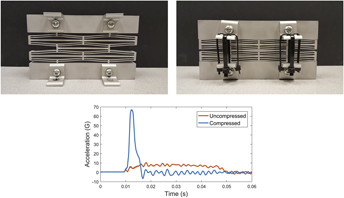Crossref Citations
This article has been cited by the following publications. This list is generated based on data provided by
Crossref.
Morris, Clinton
Bekker, Logan
Spadaccini, Christopher
Haberman, Michael
and
Seepersad, Carolyn
2019.
Tunable Mechanical Metamaterial with Constrained Negative Stiffness for Improved Quasi‐Static and Dynamic Energy Dissipation.
Advanced Engineering Materials,
Vol. 21,
Issue. 7,
Valencia, Camilo
Restrepo, David
Mankame, Nilesh D.
Zavattieri, Pablo D.
and
Gomez, Juan
2019.
Computational characterization of the wave propagation behavior of multi-stable periodic cellular materials.
Extreme Mechanics Letters,
Vol. 33,
Issue. ,
p.
100565.
Tan, Xiaojun
Wang, Bing
Chen, Shuai
Zhu, Shaowei
and
Sun, Yuguo
2019.
A novel cylindrical negative stiffness structure for shock isolation.
Composite Structures,
Vol. 214,
Issue. ,
p.
397.
Hua, Jian
Lei, Hongshuai
Zhang, Zhong
Gao, Cunfa
and
Fang, Daining
2019.
Multistable Cylindrical Mechanical Metastructures: Theoretical and Experimental Studies.
Journal of Applied Mechanics,
Vol. 86,
Issue. 7,
Tan, Xiaojun
Chen, Shuai
Zhu, Shaowei
Wang, Bing
Xu, Peifei
Yao, Kaili
and
Sun, Yuguo
2019.
Reusable metamaterial via inelastic instability for energy absorption.
International Journal of Mechanical Sciences,
Vol. 155,
Issue. ,
p.
509.
Hector, Kristiaan W.
Restrepo, David
Tejedor Bonilla, Cristian
Hector, Louis G.
Mankame, Nilesh
and
Zavattieri, Pablo D.
2019.
Mechanics of Chiral Honeycomb Architectures With Phase Transformations.
Journal of Applied Mechanics,
Vol. 86,
Issue. 11,
Tan, Xiaojun
Chen, Shuai
Wang, Bing
Zhu, Shaowei
Wu, Linzhi
and
Sun, Yuguo
2019.
Design, fabrication, and characterization of multistable mechanical metamaterials for trapping energy.
Extreme Mechanics Letters,
Vol. 28,
Issue. ,
p.
8.
Ledezma-Ramírez, Diego Francisco
Tapia-González, Pablo Ernesto
Ferguson, Neil
Brennan, Michael
and
Tang, Bin
2019.
Recent Advances in Shock Vibration Isolation: An Overview and Future Possibilities.
Applied Mechanics Reviews,
Vol. 71,
Issue. 6,
Ha, Chan Soo
Lakes, Roderic S.
and
Plesha, Michael E.
2019.
Cubic negative stiffness lattice structure for energy absorption: Numerical and experimental studies.
International Journal of Solids and Structures,
Vol. 178-179,
Issue. ,
p.
127.
Wang, Bing
Tan, Xiaojun
Zhu, Shaowei
Chen, Shuai
Yao, Kaili
Xu, Peifei
Wang, Lianchao
Wu, Huaping
and
Sun, Yuguo
2019.
Cushion performance of cylindrical negative stiffness structures: Analysis and optimization.
Composite Structures,
Vol. 227,
Issue. ,
p.
111276.
Zhang, Yunlan
Restrepo, David
Velay-Lizancos, Mirian
Mankame, Nilesh D.
and
Zavattieri, Pablo D.
2019.
Energy dissipation in functionally two-dimensional phase transforming cellular materials.
Scientific Reports,
Vol. 9,
Issue. 1,
Seriani, Stefano
2019.
A New Mechanism for Soft Landing in Robotic Space Exploration.
Robotics,
Vol. 8,
Issue. 4,
p.
103.
Chen, Shuai
Wang, Bing
Zhu, Shaowei
Tan, Xiaojun
Hu, Jiqiang
Lian, Xu
Wang, Lianchao
and
Wu, Linzhi
2020.
A novel composite negative stiffness structure for recoverable trapping energy.
Composites Part A: Applied Science and Manufacturing,
Vol. 129,
Issue. ,
p.
105697.
Box, Finn
Johnson, Chris G.
and
Pihler-Puzović, Draga
2020.
Hard auxetic metamaterials.
Extreme Mechanics Letters,
Vol. 40,
Issue. ,
p.
100980.
Tan, Xiaojun
Wang, Bing
Zhu, Shaowei
Chen, Shuai
Yao, Kaili
Xu, Peifei
Wu, Linzhi
and
Sun, Yuguo
2020.
Novel multidirectional negative stiffness mechanical metamaterials.
Smart Materials and Structures,
Vol. 29,
Issue. 1,
p.
015037.
Garland, Anthony P.
White, Benjamin C.
Jared, Bradley H.
Heiden, Michael
Donahue, Emily
and
Boyce, Brad L.
2020.
Deep Convolutional Neural Networks as a Rapid Screening Tool for Complex Additively Manufactured Structures.
Additive Manufacturing,
Vol. 35,
Issue. ,
p.
101217.
Sun, Mengnan
Dong, Zhixu
Song, Guiqiu
Sun, Xingwei
and
Liu, Weijun
2020.
A Vibration Isolation System Using the Negative Stiffness Corrector Formed by Cam-Roller Mechanisms with Quadratic Polynomial Trajectory.
Applied Sciences,
Vol. 10,
Issue. 10,
p.
3573.
Zhakatayev, Altay
Abdikadirova, Banu
Sarmonov, Shamil
and
Varol, Huseyin Atakan
2020.
Dynamics of Tensegrity Robots With Negative Stiffness Elements.
IEEE Access,
Vol. 8,
Issue. ,
p.
187114.
Ruschel, Amanda L.
and
Zok, Frank W.
2020.
A bi-material concept for periodic dissipative lattices.
Journal of the Mechanics and Physics of Solids,
Vol. 145,
Issue. ,
p.
104144.
Zhakatayev, Altay
Kappassov, Zhanat
and
Varol, Huseyin Atakan
2020.
Analytical modeling and design of negative stiffness honeycombs.
Smart Materials and Structures,
Vol. 29,
Issue. 4,
p.
045024.
